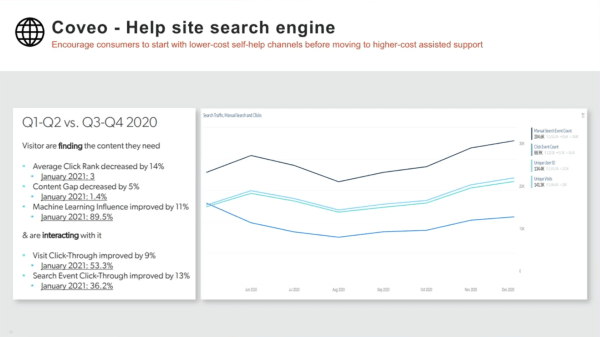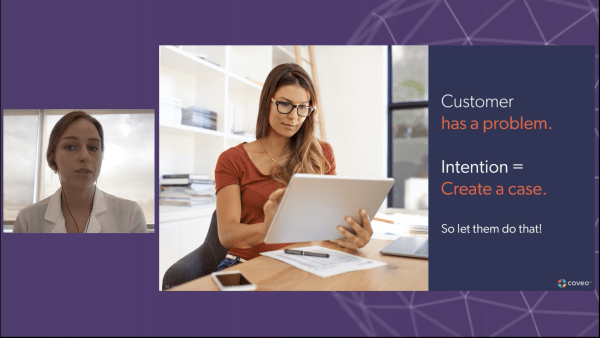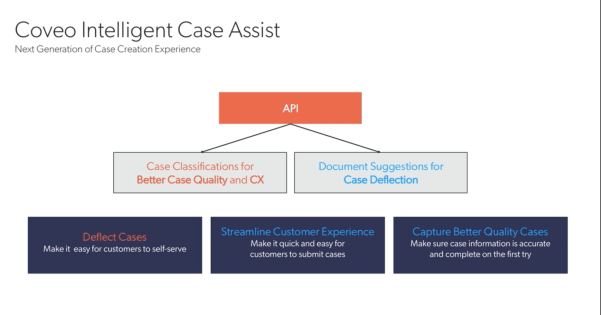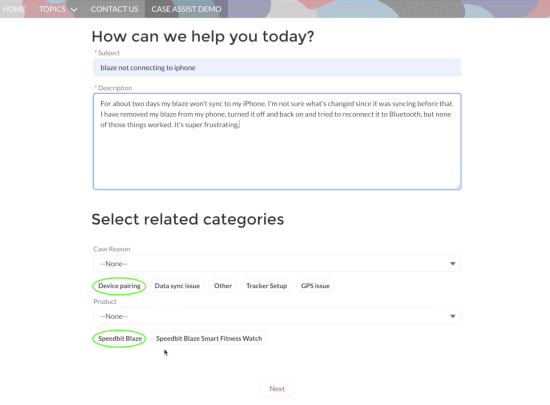Machine learning has given us a golden opportunity to build better customer service experiences — for customers and agents — based on what people actually want to achieve.
It’s also a reminder that constantly trying to reshape or redirect that behavior, especially in the name of efficiency, can be costly. As referenced in Practical Tips for Dialing Up Relevant Customer Service Experiences, 73 percent of customers will leave a brand after only three negative customer service experiences (Coveo Relevance Report 2021: Customer Service). Typically, negative means:
- Irrelevant: Unhelpful to what the customer is trying to get done
- Incoherent: Leading the customer through disunified touchpoints and making them repeat themselves
- Disjointed: Failing to learn and adapt from one interaction to the next
Harmonizing CX and Case Deflection
The good news is that reducing case volume and bringing value to customers are not mutually exclusive. At least they don’t have to be, as Matt Chinn, vice president of customer care at AARP, suggested in his recent Relevance 360 session (More Relevance, More Success in Customer Service). “Serving 38 million members like we do, it’s all about people getting value from AARP as members,” says Chinn. “That means relevant content across our help center and knowledge base, our chatbots, and, of course, our web help form.”
One of the ways that the AARP team harmonizes customer service (CX) with broader case deflection objectives is by evaluating content performance. On the help site specifically, a 14% increase in average click rank indicates that users are able to find what they need easily. The average user now sees exactly what they need within the first three search results. Confirmed cases deflected let Chinn know that his team’s focus on serving up timely, contextually relevant content in this manner is enabling more people to successfully self-serve.

Indeed, help form case creation has plummeted overall since implementing Coveo and refining AARP’s help site content. “Machine learning influence shows us how our Coveo-powered system is learning how people ask questions, taking that [data], and constantly building on itself.”
Now, the only cases that come through are those that really do require agent assistance. Win-win, right?
“Just let me submit my case already!”
While submitting a case or support ticket might not be the ideal outcome, both in terms of CX and customer service efficiency, many customers come to the case submission form because they want to submit a ticket. They either feel they’ve exhausted all self-service avenues or are determined to pick up the phone.
Ezmie Bouchard, product manager at Coveo said, “what we realized is that when a customer has a problem or issue and already tried to solve it on their own, they become intent on making a case. At that point, it’s in our best interest to make that experience as easy and seamless as possible.”

“We’ve found that in some cases it can take up to 40 clicks to submit a case. That’s not a very good experience.” That’s not good at all. It leaves one wondering how a support form requiring that many clicks is even possible. Then again, most forms put a lot of the burden on the customer to select the right category (click, click, click), or to give suggested content a shot (click).
Bouchard recommends two ways to fashion this experience so that both customers and agents get what they need.
1) Suggest Relevant Documentation
Mark Chinn and the AARP team use Document Suggestions, a part of Coveo Case Assist that uses machine learning to automatically suggest documents that are relevant to the case based on user input, including free-form text entries and category selection. In an ideal world, the customer finds what they need and abandons the case altogether. For those that do submit a case, better content and more context can be properly routed for more efficient service.

It’s a way to improve self-service success for customers, and to avoid that agent refrain you’re probably familiar with: “This could have been solved with content already on our help site.”
2) Improve Case Classification and Quality
One of the sticking points customers run into on help forms is not understanding how to categorize their cases. Often, this is a result of forms that dictate available options to the customer, instead of the other way around. Coveo Case Assist does it with Intelligent Case Classification, which lets customers describe the issue in their own words first. Only then does the system automatically suggest classifications based on the case details filled in by the customer — right there on the form.

Relevant categories are automatically generated and suggested based upon what the user types in the description box.
This is one of the customer-focused case deflection tools that Chinn has relied on to improve service efficiency. For support agents, the Case Classification feature ensures that cases are tagged accurately and precisely classified, thus avoiding two other common refrains: “I don’t have enough information to resolve this case” and “I am not the right person to resolve this case.”
Streamline Case Submission with a Purpose
What Chinn and his team do so well is meet customers where they are. They keep an ear to the ground in terms of what people need at critical points in the service journey — especially the web help form. Today, the entire experience, from self-service to case routing to agent-assisted interactions, is flush with relevant content. It’s a win-win solution that keeps both customers and agents happy throughout the case submission, management, and resolution process.
Dig Deeper
To learn more about how AARP brought relevance into the customer service experience and how you can do the same, be sure to watch More Relevance, More Success in Customer Service.
And to uncover the technological innovation driving self-service success, watch Build Relevant Self-Service Experiences with AI.


